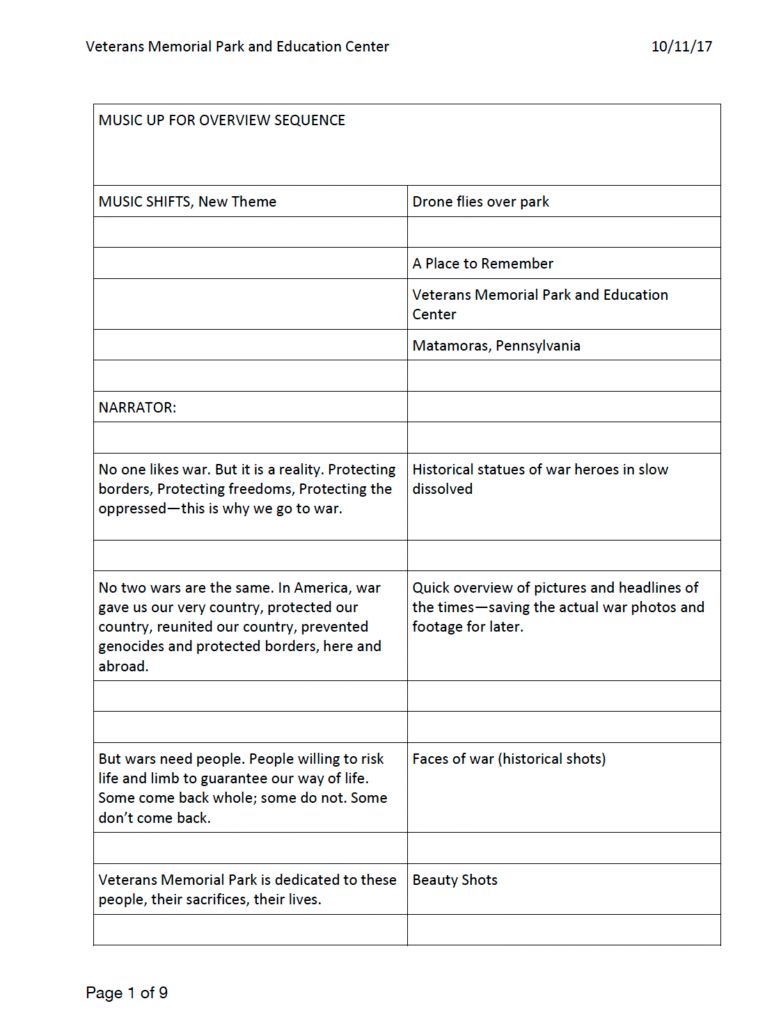What is the Process of Writing a Great Corporate Script?

There are 5 steps to writing a great corporate script.
They are:
- Research
- Outline
- Write
- Submit to client
- Rewrite based on client’s review
Herte’s a look at each phase.
Research
This the most important step. You can’t write without information.
Ask your client to describe his or hears goals for the script. Get detailed information about what the client expects the script to say. You may have to also interview other stakeholders.
Ask about tone, desired result, background, others you should interview, and deadline for the script. If the task has an insanely short deadline, negotiate for more time. That may not work, but it’s worth a try. A reasonable expectation for research and writing is about two weeks, in my estimation.
Outline
Take what you have learned and create an outline. Microsoft word has a built-in outliner. Go to the View part of the menu, and choose outline. In Pages on the Mac, simply start a new document, then type a number. This will start your outline.
n outline may look like this:
- Opening
- Show exterior of Big Corp.’s building. Start slow zoom in with camera or drone.
- Introduction. Big Corp is the biggest hydraulics provider in the U.S, from small packages, to industrial si size for excavation.
- Quick photo overview of products.
- Statement from President in his office or walking through plant thanking customers
- Extended features and benefits for the product line
- Interviews with satisfied customers
- Wrap up with quick review of shots from the video, accompanied byan animated logo And company’s catch phrase
Write the script
Now it’s time for your first draft. The format for this is two columns, one audio and one for related video.
- Write for the ear. This means verbs only when necessary
- The narration and placeholder for interviews help you.
What makes writing an AV script hard is not knowing how easy it can be. By the very nature of the written word for a visual medium, the key to success is less, not more.
For one thing, you’re writing to be heard, not seen. For another, the medium is a visual one, which means it prefers the pictures to do the talking. Finally, a script for a video needs a lot more than just words. It has to provide visual direction, audio direction, and the essential creative blueprint that leads to the success of the project.
Let me give you an example.
Let’s say that your goal is to write a short script about a new software program that helps people track their spending. Let’s call it “Fast Money“. It’s a simple, easy-to-use program that can help people budget, save, and ultimately have the money they need to fulfill their dreams.
The success of all video or audio-visual products is to engage the audience by appealing to their desires. You could talk about how “Fast Money” has been written by coders certified in C++, how it is delightful in its use of a user-friendly GUI, and how it automatically sends back error messages to “Fast Money” HQ so that the program can be constantly improved.
But you’d be talking to yourself, because the potential buyer doesn’t care about any of that. They care about money. Their money. Their life. Their future. So luckily, you don’t need to know or present all those technical facts. What you need is a way to engage the audience on their terms.
So you need to create a hook. A way to start the script that talks to them and their needs. So you begin writing:
ANNOUNCER: You want to make Money!
VISUAL: Picture of Dollar Bill.
SOUND EFFECT: Ka-Ching.
MUSIC: Money, by Pink Floyd.
Well, it’s a start, if you want to hit your audience with a sledgehammer. But hitting audiences with sledgehammers doesn’t create intrigue. But this is often the approach an unseasoned writer will take– they’ll cover all the bases.
Instead, try writing without using words– ie, skip the narrator for now and create a scene instead.
SCENE: Slow zoom in on a man working at the kitchen table. He has a yellow legal pad, a checkbook, and a calculator. He looks worried and is wiping imaginary sweat from his brow. A woman, his wife, walks in behind him and looks over his shoulder.
SHE: Well?
HE: It doesn’t look good.
ANNOUNCER: Too familiar? It’s hard to save a buck these days.
VISUAL: Alternating closeups of Husband and wife faces, cutaway to their checkbook showing small negative balance, cutaway to a pile of bills.
Now, that was fun! Instead of a litany of facts and figures, suitable only for the engineer who developed the product, we’ve now created an emotional scenario that almost anyone running a household can identify with. They’re ready to hear more.
And we didn’t use corny music, jangling cash registers, overblown prose, or dollars marching off a cliff.
Now you’re on your way to being a scriptwriter. Yes, you have to know the facts. But no, the audience doesn’t need all of them. They need reasons to care. And you’ve just given that to them. Now, they’ll listen to more— even if there are a few facts thrown in!
Review Script with Client
The best success I have had in getting success with the client is reading the script. You may notice that only the principal client is reviewing the script; other times it will be a committee of stakeholders Show enthusiasm as you readout snd describe both columns, pointing out where there are video or picture segments. Read out loud the narration, and point out the narration or music cues.
Describe each segment audio-visually, and point out text overlays and music cues. Make notes on what sentences they want changed.
Don’t make changes on the spot; go homeand rewrite on your terms, without the crushing weight of having just reviewed the script
Rewrite and Bring the Modified Script to the Client
You should now have a new script, which the client or clients should approve. Get that script to the production group in your company, Do it yourself, or hire a crew, depending on your company’s size and capability
Of course, your specialty might be writing scripts as a freelancer, which means you’ll have to wait to see the finished product.
But if you’re lucky, you’ll be onto the next, if you’re a good sales person. Once yoy have a final copy of the video, you can choose to enter your final project to a corporate video festival. When you win, you have more accomplishments that you can parlet into more business for youself!
